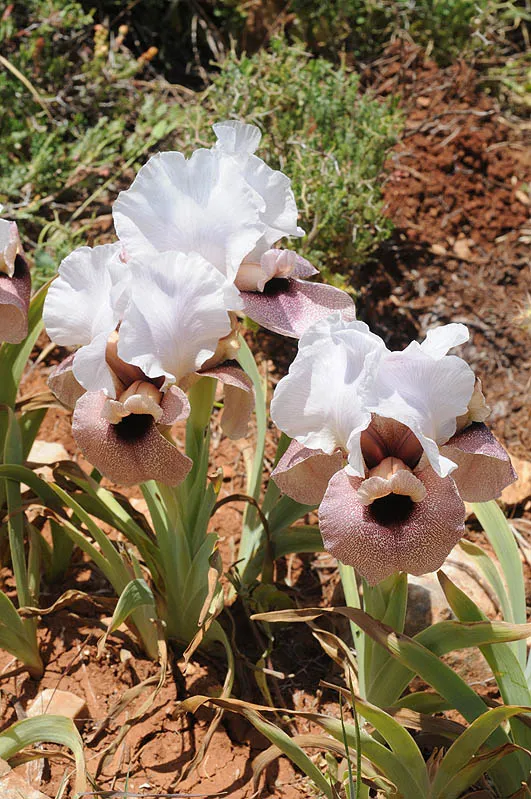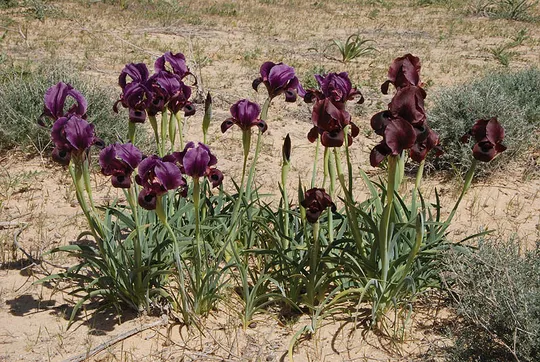Samaria Iris
Iris lortetii



Iris lortetii is a geophyte in the Iris section Oncocyclus, considered by many to be the most beautiful of all of the irises in the section. Its bluish pale-green leaves are erect and sword-like. Flowers stalks are 30-50 cm high and flower diameter is about 10 cm or more; color is white or light pink, with delicate markings of darker veins with spots and stripes. The inner perianth has a delicate purple veined pattern on a light pink background; the outer perianth segments are densely spotted in purple. The background of the spotted pattern changes from golden to brownish-yellow or light pink. There is a dark spot or a densely spotted area at the opening of the pollination tunnel. At the base of the external perianth segment, there are beardlike yellow hairs on a purple background. I. lortetii blooms from mid-April to early May.
Grows in the eastern Upper Galilee, at the western edges of the Hula Valley and in northern Samaria and in the transition area between Samaria and the Samarian Desert. In the Galilee, most of the sites are concentrated in the Dishon Stream catchment area – from Wadi Gush Halav, Mount Pu’a and the slopes in the Malkiya area to Tel Hatsor and Ayelet HaShahar in the west. A number of sites are scattered through the Ramim Mountains (Naftali Ridge) from the area of Yiftakh to the cliff above Kiryat Shmona. The known populations from the Hula Valley (Sde Eli’ezer, Ayelet Hashahar, Tel Hatsor, Ma’ayan Barukh and Tel Avel Bet-Ma’akha) are suspected of being planted by humans – at the cemeteries (Avel), in commercial fields (Sde Eli'ezer) and support-populations (Maayan Barukh).
In Samaria, the species grows in Wadi Baydan near the springs, and on the slopes of Mount Eval. Additional populations are located in the mountains east of Bit Daǧan to the village of Aqraba. Well-known populations are exist at the Migdalim Junction and on the cross-Samaria highway, near the village of Usrin. In Flora Palaestina, the species is also recorded from Giv’at HaMore, the Gilboa, Dan Valley and the Hula Valley. We are not familiar with the species on Giv’at HaMore or the Gilboa; these may be light-colored individuals of I. bismarckiana and I. haynei.
It grows on rocky limestone areas in the Mediterranean-Desert ecotone, on the edges of orchards and planted groves, and on the edges of open woodland, in well-drained soils, mostly in gray calcareous soil and also in terra-rossa soil. In the Galilee, it only grows at the edges of the Mediterranean region and descends to an altitude of 180 m. In Samaria, it grows in the western part of the Mediterranean-Desert ecotone (above an altitude of 420 m), but penetrates into the rainy, Mediterranean region in the area of Nablus.
Iris bismarckiana and I. hermona are similar to I. lortetii, but the latter is clearly distinguished from them by its lighter flowers. Its leaves are relatively wide in comparison to the other species in the section, and are only slightly curved in a scythe shape. It blooms later than all the other species growing in Israel. Iris lortetii has no closely related species in the Levant; the closest vicarious species grows in Turkey.
The Samarian populations were known for many years as an independent species called Iris samariae. The Flora Palaestina determined the status of this taxon to be a ‘Samarian variety’ – I. lortetii var. samariae. Feinbrun noted that I. samariae had a slightly larger flower than I. lortetii, and that it is slightly distinguished from it by the size and color of the flower parts and its early flowering season.
• The locations where this species grows have not been marked for development, but the major threat to the species is picking due to its extreme attractivity and its reputation among nature lovers. Lately, many patches were uprooted near Malkiya (Mike Livne).
• The species suffered from massive uprooting for exportation of its rhizomes to Europe at the end of the 19th century, almost to the point of extinction.
• The Samarian variety of Iris lortetii, which is endemic to northern Samaria, should be considered an independent taxon for purposes of nature conservation. This variety’s systematic status is equivalent to a subspecies (although not yet described as such officially). It is endangered due to uncontrolled picking and uprooting of its rhizomes. As long as the political conflict continues, the populations at En Bidan and Usrin are threatened by massive destruction; the population in Nablus at Mount Eval is apparently extinct.
• The populations are patchy and extremely disjunct. The cause of this fragmentation is unknown, nor is it clear how the plant is spread from patch to patch. Patches grow and becomes dense by vegetative reproduction. While the Galilee populations have been growing and expanding since the 1960s, the Samaria populations, particularly those near the city of Nablus, are declining and becoming extinct. The population in southern Lebanon has apparently been destroyed, thus Israel is the only remaining place in the world for its preservation.
• It is protected in the Dishon Stream Reserve and the Kiryat Shmona Reserve.
The irises growing in the Malkiya area are threatened by development, disturbance and uprooting; some of the plants should be transferred to the Tel Kadesh National Park. Individuals from the Samaria populations should be transferred to nearby refuge reserves, such as the Wadi Yitav and Kokhav HaShahar reserves, and be monitored. Individuals planted in fallow land near Ma’ayan Barukh can be used as a source for propagation.
Endemic to Israel and southern Lebanon. The species was described from the Naftali Ridge south of the Litany. There are records of its existence on the Lebanese side of the upper Galilee up to the Litany bend, where it was first collected by Lortet (Kfar Kila – Dir Mimes), but the populations in southern Lebanon are apparently extinct.
This is one of the most beautiful and rarest Israeli plants. Iris lortetii is in danger of extinction because it is endemic to Israel and grows in just a few locations in the eastern upper Galilee and northern Samaria. Although the locations are not threatened by development, plants that are not located inside nature reserves should be protected. The species is particularly endangered because of its great attractivity and its renown among nature lovers. The Samarian variety endemic to northern Samaria should be treated as an independent taxon for nature conservation purposes.
Lucas, G. and Synge, H. 1978. The IUCN Plant Red Data Book. Morges, 2 Switzerland. p. 241–242.
Current Occupancy Map
| 1000 squre meter pixel | 5000 squre meter pixel | 10000 squre meter pixel | |
|---|---|---|---|
| number of observations | 0 | 0 | 0 |
| in total pixels | 0 | 0 | 0 |
| Family | Iridaceae |
| Classification | On the endangered species list |
| Ecosystem | Semi-Steppe Belt |
| Chorotype | Eastern Mediterranean |
| Conservation Site | Near Malkyia |
| Rarity |
1
1
6
|
|---|---|
| Vulnerability |
0
0
4
|
| Attractiveness |
0
3
4
|
| Endemism |
0
4
4
|
| Red number |
1
4.2
10
|
| Peripherality | 0 |
| IUCN category | DD EW EX LC CR EN VU NT |
| Threat Definition according to the red book | Endangered |
 Based on:
Based on:






